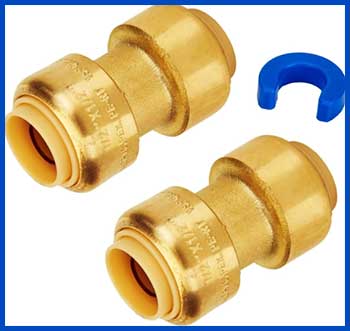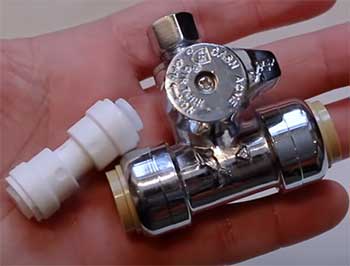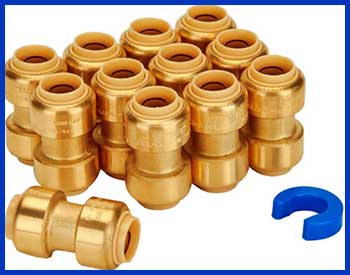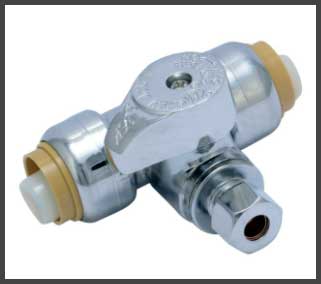I’ve spent years wrestling with pipes, sweating over soldered joints, and navigating the world of plumbing fittings. When I first heard about push-fit fittings like Sungator and SharkBite, I was skeptical—could something so simple really hold up?
In this article, I’ll walk you through my experience with these two brands, comparing their strengths and weaknesses, and sharing what I’ve learned from real-world use.
Whether you’re a DIYer or a seasoned plumber, I’ll help you decide which fitting suits your needs with a detailed pros and cons breakdown, a comparison table, and answers to common questions.
A Brief Comparison Table
| Feature | Sungator | SharkBite |
| Material | Lead-free brass | Lead-free brass |
| Pipe Compatibility | PEX, copper, CPVC, PE-RT, HDPE | PEX, copper, CPVC, PE-RT, HDPE |
| Installation Effort | Moderate (requires firm push) | Low (requires less insertion force) |
| Max Pressure | 200 psi | 400 psi (Max series) |
| Max Temperature | 200°F | 200°F |
| Warranty | 25 years | 25 years |
| Reusable | Yes, with caution | Yes, with caution |
| Approved Use | Behind walls, underground (wrapped) | Behind walls, underground (wrapped) |
| Price Range (1/2″ coupling) | $5–$8 | $8–$12 |
| Availability | Retail, online | Wider retail, online |
My Journey With Push-Fit Fittings

As a plumber, I’ve seen it all—burst pipes, leaky joints, and homeowners desperate for quick fixes.
Back in the day, soldering copper pipes was my bread and butter. It’s reliable, but it’s also time-consuming and requires a torch, flux, and a steady hand.
Then came push-fit fittings, and everything changed.
I first encountered SharkBite about a decade ago when a client needed an emergency repair under their sink.
I was amazed at how fast I could connect the pipes—no torch, no mess.
Later, I discovered Sungator, a lesser-known but equally intriguing option. Both promised to make my life easier, but I wanted to know: which one’s better?
What Are Sungator And SharkBite Fittings?
Let’s start with the basics. Sungator and SharkBite are push-fit (or push-to-connect) plumbing fittings designed to join pipes without soldering or gluing.
You simply push the pipe into the fitting, and internal components—a collet with metal teeth and an O-ring—create a watertight seal. Both brands work with a variety of pipes: PEX, copper, CPVC, PE-RT, and HDPE.
They’re marketed as time-savers, perfect for DIYers and pros alike. But while they share the same core concept, their design and performance differ in ways that matter.
SharkBite, launched in 2004, is the big name in the game. It’s owned by Reliance Worldwide Corporation and has become a staple in hardware stores. Sungator, founded in 2007, is a newer player but has gained traction for its precision and reliability.
I’ve used both in projects ranging from quick fixes under a sink to full repiping jobs, and each has its quirks.
Key Features of Sungator Fittings
Sungator fittings caught my eye for their focus on precision. Here’s what stands out:
- Durable Construction: Made from lead-free brass, they resist corrosion and hold up in harsh conditions. I’ve used them in homes with hard water, and they’ve never rusted.
- Precision Design: Sungator emphasizes a snug fit. The collet’s metal teeth grip the pipe tightly, and the O-ring creates a robust seal. I’ve noticed fewer issues with pipe slippage compared to other brands.
- Versatility: They work with multiple pipe types, making them a go-to for mixed-material systems. I once used Sungator to connect PEX to copper in a remodel, and it was seamless.
- Ease of Installation: While they require a bit more force to push in than SharkBite, the process is still tool-free. I’ve found that a clean, deburred pipe is key to a secure fit.
- 25-Year Warranty: Sungator backs its fittings with a 25-year warranty, giving me confidence in their longevity.
Pros of Sungator Fittings
I’ve come to appreciate Sungator for several reasons:
- Reliability: In my experience, Sungator fittings have a lower failure rate. I’ve installed dozens in accessible areas, and none have leaked after years of use. Plumbers I’ve spoken with praise their consistent performance.
- Cost-Effective: Sungator fittings are typically $2–$4 cheaper than SharkBite for similar sizes. For a big project, those savings add up.
- Precision Fit: The snug design reduces the chance of leaks due to pipe movement. I’ve used them in high-vibration areas, like near washing machines, with no issues.
- Professional Preference: Many pros I know prefer Sungator for permanent installations. They argue it’s less likely to pop off if installed correctly.
- Less Wear on O-Rings: Sungator’s design seems to put less stress on the O-ring during installation, which may extend its lifespan.
Cons of Sungator Fittings
No product is perfect, and Sungator has its downsides:
- Limited Availability: Unlike SharkBite, Sungator isn’t as widely stocked. I’ve had to order them online for specific projects, which can delay work.
- Steeper Learning Curve: The firmer push required can be tricky for beginners. I once saw a DIYer struggle because they didn’t insert the pipe fully, causing a drip.
- Lower Pressure Rating: At 200 psi, Sungator lags behind SharkBite Max’s 400 psi. This rarely matters for home use, but it’s a consideration for commercial jobs.
- Less Brand Recognition: Sungator doesn’t have SharkBite’s market presence, so finding compatible accessories or replacement parts can be a hassle.
Key Features of SharkBite Fittings
SharkBite is the household name, and for good reason. Here’s what I’ve learned from using them:

- Ease of Use: SharkBite’s Max series, introduced in 2023, requires half the insertion effort of its first-generation fittings. I’ve installed them in tight spaces, like behind a water heater, with no hassle.
- High Pressure Rating: The Max series boasts a 400 psi rating, double that of Sungator. This makes them ideal for high-pressure systems, though most residential setups don’t exceed 80 psi.
- Rotational Flexibility: SharkBite fittings can rotate after installation, which is a lifesaver when aligning pipes in awkward spots. I’ve used this feature to tweak connections under sinks.
- Wide Availability: You’ll find SharkBite at every major hardware store. When I needed a fitting at 8 p.m. for an emergency repair, Home Depot had me covered.
- 25-Year Warranty: Like Sungator, SharkBite offers a 25-year warranty, but only if installed per instructions and local codes.
Pros of SharkBite Fittings
SharkBite has earned its reputation, and here’s why I keep it in my toolbox:
- Super Easy Installation: The low insertion force makes SharkBite a dream for quick fixes. I’ve used them to cap a pipe in minutes during a leak emergency.
- High Pressure Tolerance: The Max series’ 400 psi rating gives me peace of mind in high-pressure systems, like those in multi-story buildings.
- Rotational Flexibility: Being able to rotate the fitting after installation is a game-changer in tight spaces. I’ve saved hours adjusting pipes this way.
- Wide Range of Products: SharkBite offers everything from couplings to ball valves. I’ve used their stop valves for shut-off applications, and they’re rock-solid.
- Trusted by DIYers: For homeowners tackling their own repairs, SharkBite’s simplicity is unmatched. I’ve recommended them to clients for minor fixes, and they love the results.
Cons of SharkBite Fittings
Despite its popularity, SharkBite has its flaws:
- Higher Cost: SharkBite fittings are pricier, often $8–$12 for a 1/2″ coupling compared to Sungator’s $5–$8. This can strain a project budget.
- Leak Concerns: I’ve heard from colleagues about occasional leaks, often due to improper installation. In one case, a client’s SharkBite popped off because the pipe wasn’t deburred.
- O-Ring Durability: The rubber O-ring can wear out over time, especially in chlorinated water. I’ve replaced a few after 5–7 years due to slow drips.
- Professional Skepticism: Many plumbers I know avoid SharkBite for permanent installations, citing soldering’s proven track record. This can make it hard to find pros willing to use them.
- Not Ideal for Concealed Use: While approved for behind-wall and underground use, I’m wary of installing SharkBite in inaccessible spots due to potential O-ring degradation.
My Experience With Sungator And SharkBite

Let me share a story.
A few years back, I was called to a rental property with a leaking water heater connection.
The homeowner wanted a quick fix, so I grabbed a SharkBite 1/2″ coupling. It went on in seconds, and the leak stopped.
The client was thrilled, but I warned them it was a temporary solution. Sure enough, two years later, I got a call about a slow drip.
The O-ring had started to degrade, likely due to the chlorinated water. I replaced it with a soldered joint for longevity.
Contrast that with a Sungator fitting I used in a bathroom remodel. The client had a mix of copper and PEX pipes, and I chose Sungator for its precision fit. The installation took a bit more effort, but the connection has held strong for four years with no issues.
The tighter grip gave me confidence, especially since the fittings were under a sink where vibration was a concern.
These experiences taught me that context matters. SharkBite shines for quick, accessible repairs, while Sungator feels more reliable for long-term use, especially in mixed-material systems.
Which Should You Choose?
Let’s get analytical. If you’re a DIYer working on a small project, like fixing a leaky sink, SharkBite’s ease of use and availability make it the better choice. Its rotational flexibility and low insertion force are perfect for tight spaces or when you’re in a rush.
I’ve recommended SharkBite to homeowners who want to tackle repairs without buying a torch or crimping tool.
For larger projects, like repiping a house, I lean toward Sungator. Its precision fit and lower cost make it ideal for pros or DIYers handling multiple connections. The slightly higher installation effort is worth it for the reduced risk of leaks.
Plus, plumbers I’ve worked with trust Sungator more for permanent installations, which aligns with my experience.
Pressure and temperature ratings are another factor. Most homes operate at 40–80 psi and temperatures below 140°F, so both brands are overkill in that regard.
But if you’re working on a commercial system with higher pressures, SharkBite Max’s 400 psi rating gives it an edge.
Cost is a big consideration. If you’re doing a full repipe, Sungator’s lower price per fitting can save you hundreds. For a single repair, though, SharkBite’s availability might outweigh the extra couple of bucks.
Installation Tips From The Field
No matter which brand you choose, proper installation is everything. Here’s what I’ve learned:

- Prep the Pipe: Always deburr the pipe end with a deburring tool or emery cloth. A rough edge can damage the O-ring, causing leaks. I’ve seen too many DIYers skip this step and regret it.
- Cut Straight: Use a tubing cutter, not a hacksaw, for a clean, square cut. A jagged edge can compromise the seal.
- Insert Fully: Push the pipe in until it hits the tube stop. SharkBite Max requires a specific insertion depth, so check the manual. Sungator’s snug fit makes it obvious when it’s seated.
- Check for Leaks: After installation, turn on the water and inspect for drips. I once caught a tiny leak because I hadn’t pushed a Sungator fitting in far enough.
- Avoid Concealed Use: Both brands are approved for behind-wall and underground use (with wrapping), but I prefer soldering for anything inaccessible. If you must use push-fit, make sure it’s accessible for future checks.
The Plumber’s Perspective: Why The Divide?
I’ve talked to dozens of plumbers about push-fit fittings, and opinions are split. Traditionalists swear by soldering, arguing it’s proven to last 50+ years. They see push-fit fittings as a shortcut, great for emergencies but risky for permanent setups.
The O-ring is the main sticking point—it’s a rubber component that can degrade over time, especially in chlorinated water or high-heat conditions.
On the flip side, younger plumbers and DIYers love the speed and simplicity. I’ve seen entire homes repiped with SharkBite or Sungator in half the time it takes to solder. The key is installation quality.
A poorly soldered joint can leak just as easily as a poorly installed push-fit fitting.
Frequently Asked Questions (FAQ)
Many plumbers avoid SharkBite for permanent installations because the rubber O-ring may degrade over time, especially in chlorinated water, leading to potential leaks. They trust soldering for its proven durability.
Lawsuits involving SharkBite often relate to PEX systems, alleging that brass fittings with high zinc content may fail due to dezincification when exposed to water, causing leaks. These claims are still under investigation.
Yes, SharkBite fittings can fail, usually due to improper installation, such as not deburring the pipe or failing to insert it fully. O-ring degradation over time can also cause leaks.
Alternatives include Sungator push-fit fittings, soldered copper joints, compression fittings, or ProPress fittings. Soldering is preferred for permanent, concealed installations due to its long-term reliability.
Conclusion: Your Choice, Your Pipes
You’re standing at a crossroads, pipes in hand, deciding between Sungator and SharkBite. I’ve been there, and here’s my take: SharkBite is your go-to for quick, accessible repairs—its ease and availability are unmatched.
But for long-term projects or mixed-material systems, Sungator’s precision and cost savings win me over. Both are solid options, but your choice depends on your project’s scope, budget, and whether you trust push-fit for the long haul.
Prep your pipes right, follow the instructions, and you’ll have a leak-free system—whether you go with Sungator’s snug fit or SharkBite’s slick installation.
